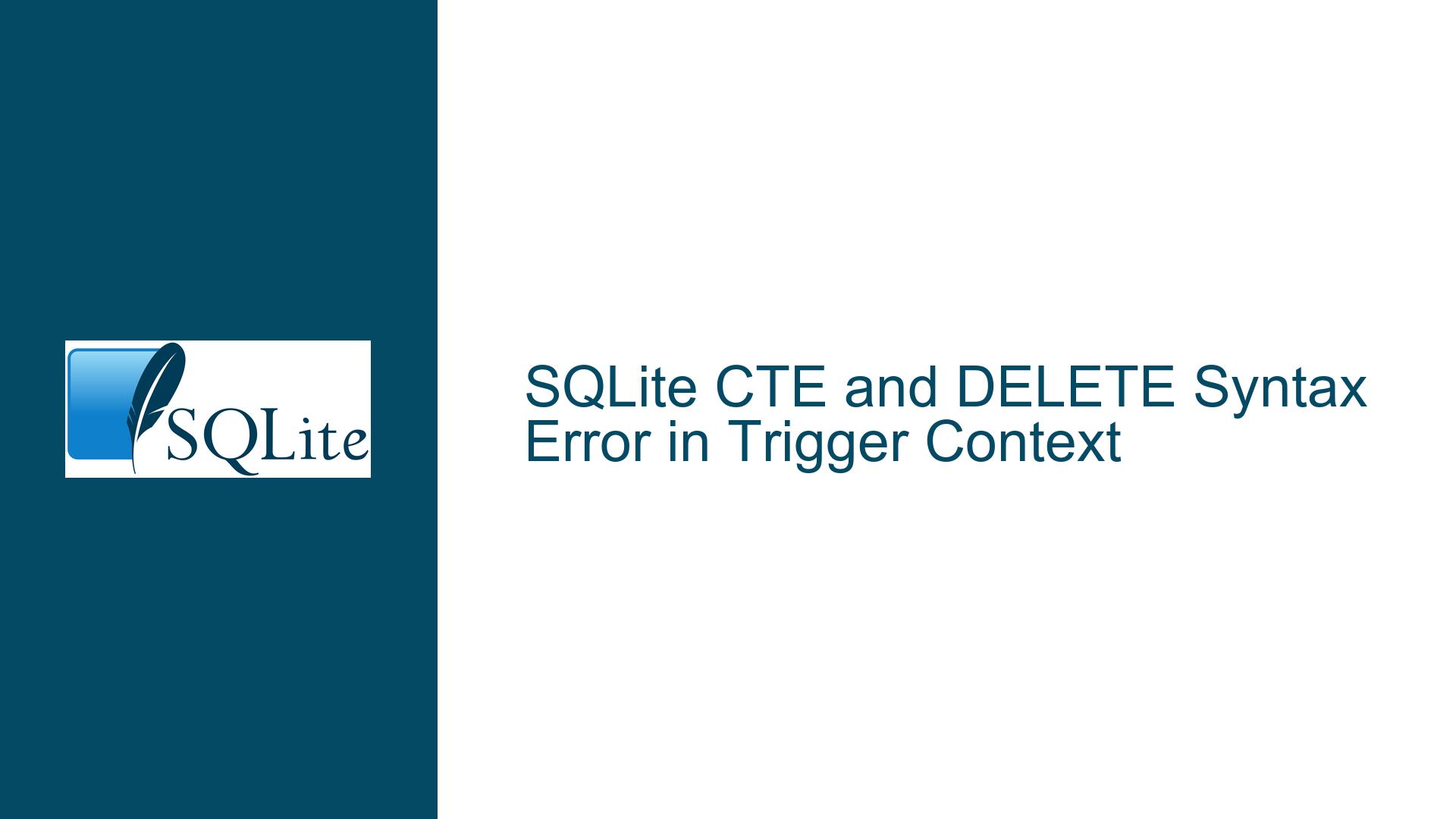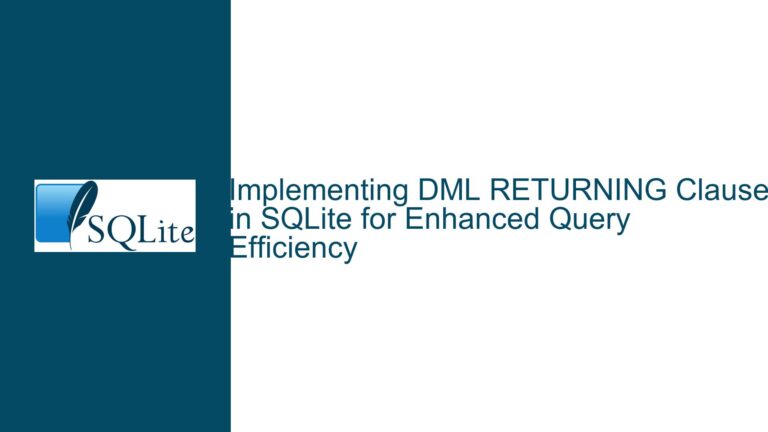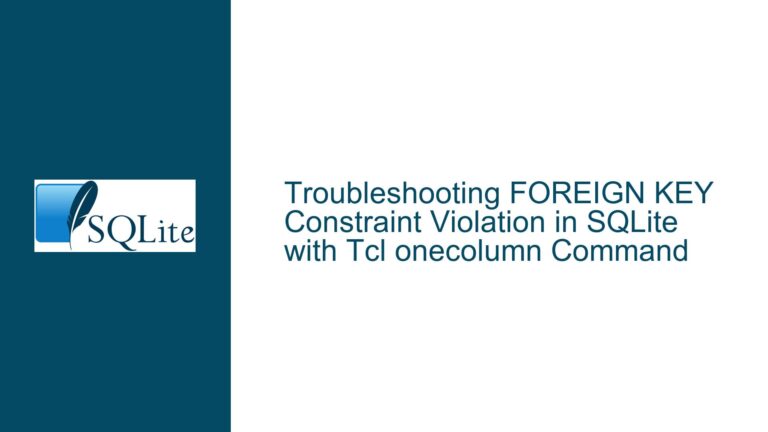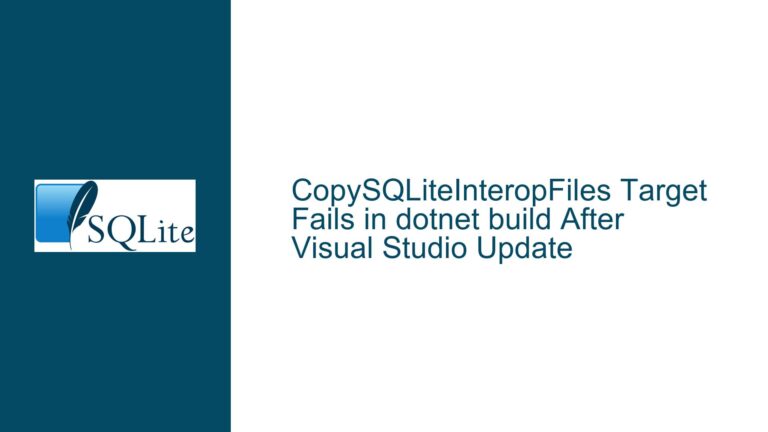SQLite CTE and DELETE Syntax Error in Trigger Context
CTE and DELETE Statement Syntax Error in SQLite Trigger
When working with SQLite, combining Common Table Expressions (CTEs) with DELETE statements can be a powerful tool for managing complex data manipulations. However, this combination can lead to syntax errors, especially when used within the context of triggers. The issue arises when attempting to use a CTE to define a set of data to be deleted, but the SQLite parser rejects the DELETE statement with a syntax error. This problem is particularly prevalent when the CTE and DELETE statement are part of a trigger on a view, as SQLite imposes specific restrictions on the syntax allowed within triggers.
The error message typically encountered is "near ‘DELETE’: syntax error," which can be misleading because it does not directly indicate the root cause of the problem. This error occurs even when the DELETE statement is syntactically correct outside of the trigger context. The core issue lies in SQLite’s internal restrictions on the use of CTEs within triggers, which are not immediately obvious from the error message alone.
SQLite Trigger Restrictions on CTE and DELETE Operations
The primary cause of the syntax error when using a CTE with a DELETE statement in SQLite is the restriction imposed by SQLite on the use of CTEs within triggers. According to the SQLite documentation, triggers do not support the use of CTEs in UPDATE, DELETE, or INSERT statements. This restriction is not explicitly mentioned in the error message, leading to confusion and frustration for developers who are unaware of this limitation.
The restriction is rooted in the way SQLite processes triggers. Triggers in SQLite are designed to execute a set of SQL statements in response to specific events, such as INSERT, UPDATE, or DELETE operations on a table or view. However, the SQLite parser does not support the use of CTEs within the body of a trigger. This limitation is likely due to the complexity of parsing and executing CTEs within the context of a trigger, which requires additional handling of temporary result sets and recursive queries.
When a CTE is used within a trigger, the SQLite parser fails to recognize the CTE as a valid construct, resulting in a syntax error. This error occurs regardless of whether the CTE is used in a SELECT, DELETE, or UPDATE statement within the trigger. The error is particularly confusing because the same CTE and DELETE statement combination may work perfectly fine outside of the trigger context.
Resolving CTE and DELETE Syntax Errors in SQLite Triggers
To resolve the syntax error when using a CTE with a DELETE statement in a SQLite trigger, developers must avoid using CTEs within the trigger body. Instead, they can use alternative approaches to achieve the same result. One such approach is to use a temporary table to store the intermediate results that would otherwise be generated by the CTE. The temporary table can then be used in the DELETE statement within the trigger.
Here is an example of how to rewrite the original query using a temporary table instead of a CTE:
-- Create a temporary table to store the intermediate results
CREATE TEMPORARY TABLE NODES_TO_REMOVE AS
WITH RECURSIVE NODES_TO_REMOVE (CHAIN_ID, NODE, SERIAL_NUMBER, NEXT_PTR) AS (
SELECT
CHAIN_ID,
NODE,
SERIAL_NUMBER,
NEXT_PTR
FROM DCD_MODIFY_DAISY_CHAIN
WHERE CHAIN_ID == (SELECT VALUE FROM _Variables WHERE NAME == 'CHAIN_ID')
AND NODE > (SELECT VALUE FROM _Variables WHERE NAME == 'NODE')
UNION
SELECT
CHAIN_ID,
NODE,
SERIAL_NUMBER,
NEXT_PTR
FROM DCD_MODIFY_DAISY_CHAIN
WHERE SERIAL_NUMBER == NEXT_PTR
)
SELECT * FROM NODES_TO_REMOVE;
-- Use the temporary table in the DELETE statement
DELETE FROM DAISY_CHAINED_DEVICES
WHERE (DCD_ID == (SELECT CHAIN_ID FROM NODES_TO_REMOVE))
AND (DCD_NODE IN (SELECT NODE FROM NODES_TO_REMOVE));
-- Drop the temporary table after use
DROP TABLE NODES_TO_REMOVE;
In this approach, the CTE is replaced with a temporary table that stores the intermediate results. The temporary table is then used in the DELETE statement, which is executed within the trigger. This approach avoids the use of CTEs within the trigger body, thereby circumventing the syntax error.
Another alternative is to use a subquery instead of a CTE. Subqueries are supported within triggers and can be used to achieve similar results. However, subqueries may not be as efficient as CTEs for complex recursive queries, so this approach should be used with caution.
Here is an example of how to rewrite the original query using a subquery instead of a CTE:
DELETE FROM DAISY_CHAINED_DEVICES
WHERE (DCD_ID == (SELECT CHAIN_ID FROM (
SELECT
CHAIN_ID,
NODE,
SERIAL_NUMBER,
NEXT_PTR
FROM DCD_MODIFY_DAISY_CHAIN
WHERE CHAIN_ID == (SELECT VALUE FROM _Variables WHERE NAME == 'CHAIN_ID')
AND NODE > (SELECT VALUE FROM _Variables WHERE NAME == 'NODE')
UNION
SELECT
CHAIN_ID,
NODE,
SERIAL_NUMBER,
NEXT_PTR
FROM DCD_MODIFY_DAISY_CHAIN
WHERE SERIAL_NUMBER == NEXT_PTR
) AS NODES_TO_REMOVE))
AND (DCD_NODE IN (SELECT NODE FROM (
SELECT
CHAIN_ID,
NODE,
SERIAL_NUMBER,
NEXT_PTR
FROM DCD_MODIFY_DAISY_CHAIN
WHERE CHAIN_ID == (SELECT VALUE FROM _Variables WHERE NAME == 'CHAIN_ID')
AND NODE > (SELECT VALUE FROM _Variables WHERE NAME == 'NODE')
UNION
SELECT
CHAIN_ID,
NODE,
SERIAL_NUMBER,
NEXT_PTR
FROM DCD_MODIFY_DAISY_CHAIN
WHERE SERIAL_NUMBER == NEXT_PTR
) AS NODES_TO_REMOVE));
In this approach, the CTE is replaced with a subquery that generates the intermediate results. The subquery is then used in the DELETE statement within the trigger. This approach avoids the use of CTEs within the trigger body, thereby circumventing the syntax error.
In conclusion, the syntax error encountered when using a CTE with a DELETE statement in a SQLite trigger is caused by SQLite’s restriction on the use of CTEs within triggers. To resolve this issue, developers can use temporary tables or subqueries to achieve the same result without using CTEs within the trigger body. By understanding the limitations of SQLite triggers and using alternative approaches, developers can avoid syntax errors and ensure that their triggers function as intended.






